![]() MARK GARDINER (with help
from Neil Mackenzie)
MARK GARDINER (with help
from Neil Mackenzie)
![]()
Day Six - Thursday 24 May
Thursday dawned bright and sunny, and remained very warm all day, particularly in the "tin box on wheels" (cf. Clive Harris) as the Daewoo's aircon was unserviceable. The area to be covered today was to the east & south-east of Ypres and included many of the most famous sites in The salient, covering the entire span of the war from the early battles of First Ypres to the advances during the Last Hundred Days.
The first cemetery to be visited today was La Brique Military Cemetery No.1, a very small cemetery which, as it is sited very close to Ypres, is surprisingly rarely visited. Buried there are: -
Private Patrick Nolan of 2nd Bn. Royal Irish Regiment on the anniversary of his death (24 May 1915); and:
Private Henry Maltby of 1st Bn. The Buffs (East Kent Regiment) from Strood who enlisted in the militia in 1907 aged 17 before joining 3rd Bn. The Buffs in 1908, being re-engaged for four more years in 1913. He joined the 1st Bn. in November 1914 and was killed in action on 21 September 1915.
Immediately across the road is the larger La Brique Military Cemetery No.2 which is equally lightly frequented, and where the centre section of turf has been removed and the ground recently reseeded.
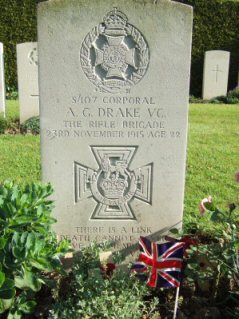 |
It is the final resting place of Corporal Alfred Drake VC of 8th Bn. Rifle Brigade, born in December 1893. On 23 November 1915, near the hamlet of La Brique, Corporal Drake was one of a patrol of four which was reconnoitring towards the German lines. The patrol was discovered when close to the enemy who opened fire with rifles and machine gun, wounding the officer and one of the men. The latter was carried back by the last remaining man and Corporal Drake stayed with his officer, bandaging his wounds regardless of the enemy's fire. Later, a rescue party found the officer, alive and bandaged, but the corporal was dead. An extract from "The London Gazette," No. 29447, dated 21 January 1916, records the following:- "For most conspicuous bravery on the night of 23rd Nov., 1915, near La Brique, France. |
He was one of a patrol of four which was reconnoitring towards the German lines. The patrol was discovered when close to the enemy who opened heavy fire with rifles and a machine gun, wounding the Officer and one man. The latter was carried back by the last remaining man. Corporal Drake remained with his Officer and was last seen kneeling beside him and bandaging his wounds regardless of the enemy's fire. Later a rescue party crawling near the German lines found the Officer and Corporal, the former unconcious but alive and bandaged, Corporal Drake beside him dead and riddled with bullets. He had given his own life and saved his Officer." He was aged 21. The officer was Lt. (later Capt.) Henry Tryon who was subsequently killed at Delville Wood on 15 September 1916 & is commemorated on the Thiepval Memorial.
On the Ypres to Sint-Jan road stands the large, well-laid out White House Cemetery, St. Jean-les-Ypres, which became a concentration cemetery after the war. One wonders why graves were moved here from sites in the Zantvoorde and Voormezele sectors when there are large cemeteries laid out in those villages. We were visiting: -
Private George Lively of 2nd Bn. Coldstream Guards, who died on 30 March 1916 aged 23 and whose family lived in Britannia Road, Great Harwood, on whose memorial he is commemorated.
Brigadier General Julian Hasler, a General Staff Officer commanding 11th Infantry Brigade, formerly of 1st Bn. The Buffs (East Kent Regiment), who was killed on 26 April 1915 aged 46 during Second Ypres. He attended Winchester College and Sandhurst Military Academy before joining The Buffs in 1888 as a Second Lieutenant, and being the recipient of regular promotions becoming Lieutenant Colonel in 1910. He served extensively in South Africa, Africa and on the North West Frontier in India, raising Hasler's Australian Scouts in the Boer War where he was severely wounded. Married with two young sons, he went to the front at the beginning of the war in command of his battalion, and was wounded on 22 October 1914 at Radinghem. He returned to France in December, and at the end of February 1915 was promoted to Brigadier General and appointed to command the 11th Infantry Brigade. He had been twice mentioned in Despatches. He was killed in action by an enemy shell on 26 April 1915 (according to CWGC) but a day later according to other sources, when his brigade took over the front line from Berlin Wood to Fortuin. General Bulfin (OC 28th Division) commented "I saw poor Julian Hasler on the 27 April, the place was being heavily shelled - I sent him up Grogan and Le Preu, my GSO2 and 3, to help him, and some signallers, but all the lines were constantly cut so I ordered him to get out as soon as it was dark. He was killed about 9 pm that night - he could have got out at 6 pm but delayed."
On to Wieltje Farm Cemetery which is not visible from the road, being sited in the middle of fields between the Wieltje Road and the N38 major road, and accessible only via a long pathway between buildings. Given this isolated spot, its small size (just over 100 graves) and the short period the cemetery was open (July to October 1917) we were surprised to find the visitors' book was quite full. The retaining wall is in need of repair, and has actually collapsed at one corner. We were visiting Lieutenant William Roughsedge of 8th Bn. Middlesex Regiment, a salesman / draper from Stratford who had attended Arundel and Richmond Technical Institute, and been in 4th City of London Territorials (Queen Victoria's Rifles) for four years until 1909. He attested to the 9th Bn. County of London Regiment, arriving in France in December 1914, before attending an Australian Voluntary Hospital in January 1915 before returning to England, being reassigned to the 3rd/9th Bn. London Regiment and returning to France in May 1915. In September 1916 he was wounded at Leuze Wood as a result of a bomb explosion when he received several small wounds behind his left ear. He was passed fit for active military service in January 1917, and was killed in action on 25 September 1917 aged 27.
A few hundred yards up the road is the irregularly-shaped but large Oxford Road Cemetery, where the CWGC gardeners were once again hard at work. This is the burial place of the famous Kent and England cricketer Serjeant Colin (Charlie) Blythe of 12th Bn. King's Own Yorkshire Light Infantry, originally from Deptford.
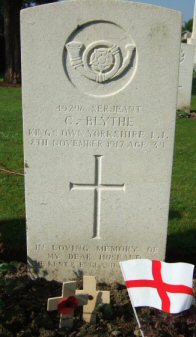
An epilepsy sufferer, he had joined the Kent Fortress Engineers, a territorial battalion of the Royal Engineers in October 1915 when he was really medically unfit for active service. In September 1917 he embarked for France and joined the pioneer battalion of the KOYLI, and after training in the Watou area was involved in the laying of the Forest Hall light railway when he was killed by a shrapnel shell on 8 November 1917. Also killed by the same shell and buried close by are: Osmond Salt; Harry Dye; Edward Bennett; and Ernest Smith.
Sadly, the cemetery register is missing from Aeroplane Cemetery although the visitors' book remains safe. The cemetery lawn is beautiful. We were visiting: -
Private Thomas Tigg of 26th Field Ambulance, Royal Army Medical Corps from Holloway Road, North London, who occupation when he enlisted in September 1914 for the duration was given as labourer or hospital subordinate with St. John's Ambulance. He went to France in 1915 where he suffered from both measles and influenza, and gained a Good Conduct Badge. He was killed in action on 20 September 1917 aged 25, possibly when acting as a stretcher bearer based at Bavaria House who were tasked with clearing casualties from behind the centre of the advance of 27th Infantry Brigade and evacuating them to Potijze Chateau ADS.
Private John Moore of 8th Bn. East Lancashire Regiment, who died on 22 September 1917 and is commemorated on the Accrington Roll of Honour.
The grouping of cemeteries around Potijze are all reached via a shale path between the houses.
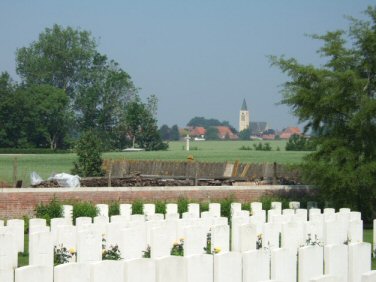
Potijze Chateau Lawn Cemetery forms part of one larger cemetery with Potijze Chateau Grounds Cemetery, where the dividing line is a tiny wall with the former being at a slightly lower level than the latter. The headstones facing west are more heavily weathered than the others, and the air is heavily scented with the roses staring to bloom nicely. Treating this as one large burial plot we were visiting: -
Private George Aslin of 8th Bn. Middlesex Regiment, from Hampton, Twickenham, who was a fitter's labourer employed by the Metropolitan Water Board. He enlisted aged 21 in 1913 and embodied in service on 10 August 1914, seeing overseas service at Gibraltar before arriving in France in March 1915. His service record indicates he was killed in action at Zonnebeke on 30 April 1915 aged 23, although it is possible he died of wounds given his burial location at an ADS site and that the CWGC give his date of death as 11 May 1915.
Lieutenant Cyril Graham of 5th Bn. Border Regiment who was born in 1895 at Aspatria, Northumberland, the son of an employee of the Joint City & Midland Bank. A mining engineer he had been commissioned in 1913 and died on 27 May 1915 aged 19. The battalion was split between other units of 10th Infantry Brigade and Graham's 'A' Coy. was allocated to 1st Bn. Royal Irish Fusiliers and occupied trenches on the left and right of St Jean-St Julien road near St Jean and La Brique. According to the War Diary on 24 May 1915 the enemy attacked with poisonous gas, the attack being repulsed but there were heavy losses on account of the gas; this was the final German attack launched as the Battle of Bellewaarde Ridge and ended the Second Battle of Ypres. Difficulty was experienced in accounting for casualties owing to the battalion being split up. On 27 May 1915 the War Diary notes that Lieut. Graham had been killed in action but gives no more detail.
The cross of sacrifice in Potijze Chateau Wood Cemetery is visible above the crops from Potijze Chateau Lawn and Grounds Cemeteries, and can only be reached via a grass path from the latter. It is surprising that this cemetery seems to attract far fewer visitors than the two others, as the visitors' book has dates back as far as 1998. Among those buried in the cemetery are 46 officers and men of the 2nd Bn. Hampshire Regiment and 19 of the 1st Bn. Royal Inniskilling Fusiliers who died in a gas attack on 9 August 1916, including Second Lieutenant Francis Kelly of 5th Bn. Connaught Rangers, who was attached to the 1st Bn. Royal Inniskilling Fusiliers and died aged 23. From Fernmount, Granard, Co. Longford, he was serving in the 31st Bn. COEF and joined up in November 1914 before joining the Cork School of Instruction in October 1915. His battalion was in Congreve Walk on 9 August 1916 and the War Diary states the enemy made a heavy and very concentrated discharge of gas at our lines starting at 22.30 it lasted for over 2 hours. Our casualties were heavy especially in C Coy which was in the left sub-sector. Owing to our Lewis Gun fire being kept up during the whole attack on the enemy parapet and our own close artillery support the enemy did not leave his trenches. 7 Officers & 42 other ranks were killed outright, with a further 39 other ranks dieing afterwards. Casualties all occurred from effects of gas with the exception of a few who were killed during the bombardment of our trenches.
Heading back towards Ypres is Pojitze Burial Grounds Cemetery, a large and spacious cemetery set at the side of a well-used road with plenty of lorries heading towards the motorway. We were visiting: -
Rifleman Harry Libby of 16th Bn. London Regiment (Queen's Westminster Rifles) whose family came from Thornton Heath in Surrey and he attended the local Whitgift Middle School. Employed by H.M. Board of Trade, he died aged 21 on 18 January 1916.
Private Thomas Colpitts of 14th Bn. Durham Light Infantry, a coal miner from Washington, Co. Durham, who enlisted at Sunderland in February 1915 aged 35. He was killed in action on 19 December 1915.
Private Tom Clark of 1st Bn. King's Own Shropshire Light Infantry, a native of Accrington who is commemorated there, and who died on 14 September 1915 aged 23.
Ypres Town Cemetery is the major municipal graveyard on the eastern outskirts of town. CWGC headstones can be found in approximately three separate plots, one in the angle of the south-west corner which is mostly composed of officers' graves, and two plots scattered in the centre of the communal cemetery, which bears an untidy air. Buried amongst the officer is Private Ralph Kinsey of 1st/5th Bn. York & Lancaster Regiment, a cotton piecer from Rochdale who attested aged 16 in September 1916, before being mobilised and joining the Lancashire Fusiliers in May 1917, where he contracted syphilis and was hospitalised for 94 days. Shortly afterwards he was transferred to 4th Bn. Loyal North Lancashire Regiment before joining the York & Lancaster Regiment in May 1918. He is listed as being killed in action on 6 June 1918 but his burial here appears unusual not only the in the location of the cemetery but also that he is buried in what appears to be an officers' plot as opposed to the other burial plots available.
Adjacent to the communal cemetery is Ypres Town Cemetery Extension, by contrast a regular CWGC burial ground which looks immaculate, especially compared to its neighbour. It contains the resting place of several IWGC / CWGC gardeners and family. We were visiting: -
Corporal Herbert Cordery of 6th Dragoons (Inniskilling) who died on 11 February 1915 aged 29 whilst attached to 1st Life Guards, and is commemorated on both the Coulsdon and Purley & Coulsdon war memorials.
Driver Thomas Marshall of 2nd (Northumbrian Brigade), Royal Field Artillery on the anniversary of his death on 24 May 1915 aged 21. A labourer with the Hull Brewery he enlisted in April 1913 with the Territorial 2nd Northumbrian Brigade and arrived in France in April 1915.
Set on the side of the busy Menin Road is the large Menin Road South Cemetery, with the headstones laid out in parade-ground order (both in formation and appearance). We were visiting: -
Private Arthur Noble of 2nd Bn. West Yorkshire Regiment (Prince of Wales's Own), a railway worker from Meltham, Yorkshire, whose wife lived in nearby Holmfirth. Called up in February 1917, he was sent to France in May 1917 and was killed in action on 22 June 1917 aged 29. He is buried in a mass grave and one of five names on the headstone.
Major Richard Dunn Warren of 11th Bn. Leicestershire Regiment, who was born in Grimsby and was a native of Washingborough, Lincolnshire. Educated at Malvern, Eton and Hertford College, Oxford, he served as a subaltern in the 2nd Bn. Lincolnshire Regiment in the South African War 1899-1902 before retiring from the army in 1913. In October 1914 he rejoined and saw action in France & Flanders before being posted to Salonika as Commanding Officer of a battalion of the Connaught Rangers, before being invalided home in 1917, when he married Emily Cecile Formby on 11 August 1917. He returned to France as Commanding Officer of the 11th Bn. Leicestershire Regiment where he was killed in action on 7 April 1918 aged 39. The story of his death was relayed to us by Clive Harris: "Private Clarrie Carlton accompanied the Major on a recce up to the cutting near Railway Wood. As they approached they heard a shell coming close and dove to the ground but it did not explode. When the Private got up he noticed the unexploded shell and asked the Major if he was OK. The Major replied that he had been hit and Private saw that the shell had passed clean through the Major's body who died at that stage. Clarrie carried body back to Cem where he was buried and used to visit grave whenever he returned to Ypres thereafter."
Bombardier George Key of "A" Battery, 15th Brigade, Royal Field Artillery, who died on 14 October 1917 aged 40. He is commemorated on both the Coulsdon and Purley & Coulsdon war memorials.
Heading out of Ypres along the Menin Road is Birr Cross Roads Cemetery, a possible resting place of Neil's great-uncle, Corporal A C Dingle, who has no known grave and is commemorated on the Menin Gate. The cemetery register is missing although the visitors' book remains; some headstones are in a poor condition being heavily weathered. Definitely buried here is Private Joseph Bardsley of 13th Bn. Cheshire Regiment, a dairyman from Cheadle Hulme. He enlisted in December 1915, before being sent to France in August 1917. On 14 August 1917 his battalion moved from reserve at Ouderdom and relieved battalions of the London Regiment on Bellewaerde Ridge and at Bellewaerde Farm; two other ranks were killed, one of whom was Pte. Bardsley aged 36.
Next onto one of the most unique cemeteries on the Western Front - R.E. Grave, Railway Wood - where there are no headstones, only a cross of sacrifice bearing the names of 12 soldiers involved in mining work whose bodies were never recovered from the tunnels below.
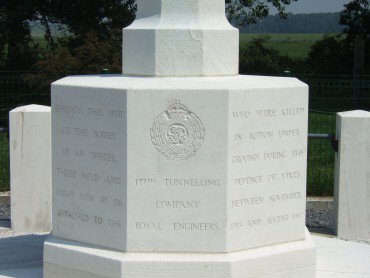
There is a great panoramic view from here of Ypres and the battlefields of 1915, but there is no registry box. Commemorated here is Second Lieutenant Charles Boothby of 177th Tunnelling Coy. Royal Engineers, who joined up in December 1914the day before his twentieth birthday, before being seconded to the Royal Engineers. He was killed in action on 28 April 1916 and as his body was not recovered his father refused to believe the news, which may have hastened his own death shortly afterwards. The book "Thirty-odd Feet Below Belgium: An Affair of Letters in the Great War 1915-1916" edited by Arthur Stockwin are the letters between Charles and his sweetheart Edith Ainscow (the editor's mother), who was aged 18 when Charles went to France in 1915.
After lunch at the museum at Hooge, we crossed the Menin Road to Hooge Crater Cemetery, where the lawn was receiving a trim; the size of this cemetery comes as a surprise as the ground drops away for some distance from the road, showing the value of this much fought over are of ground. The headstones at the bottom of the cemetery appear to have recently been cleaned, re-pointed or replaced, as the lettering is very sharp-edged. It is a reasonable assumption that many of the unknown casualties buried here date back to the early battles of 1914 & 1915. We were visiting: -
Captain Charles Winterbottom of 3rd Bn. South Lancashire Regiment, a circuit manager from West Derby, Liverpool. He was attached to the 3rd Battalion which on 2 August 1917 which was holding positions in heavy rain from 50 yards west of Ziel House to the Ypres-Roulers railway. According to the War Diary: "Still raining heavily, Battalion in same position and endeavouring to dig in - a most difficult and almost impossible task owing to the awful state of the ground and the harassing effect of sustained hostile shelling. All ranks in a deplorable condition being sodden with rain and mud. Considerable difficulty experienced in getting up rations and supplies: the state of the ground and constant shelling rendered movement both difficult and hazardous. Shortly after midnight a party of about 20 men were sheltering on the westerly side of Battalion HQ dug out when a shell landed in the middle of them and killed the whole party." Capt. Winterbottom was killed in action aged 31, possibly by this shell.
Private Fred Altham of 2nd Bn. Gordon Highlanders, who enlisted in Blackburn and is commemorated on the Great Harwood war memorial; he died on 26 October 1917.
Visible from Hooge is Sanctuary Wood Cemetery, where the ground is listed as being under renovation, and it badly needs it as the ground is uneven and the grass patchy. Possibly this resulted in the paucity of flowers, which meant that this was one of the least colourful cemeteries we visited. In addition the grave we were seeking, that of Corporal Frank Godson of 1st/6th Bn. Sherwood Foresters (Notts & Derby Regiment), was mis-recorded on the cemetery register and it took us some minutes to locate his headstone in another row. A coal miner from Sutton-in-Ashfield, Nottinghamshire, (originally employed at Tibshelf Collieries as a 14-year old underground colliery pony driver), he was a pre-war member of the 8th Territorial Battalion of the Sherwood Foresters, who embarked with this battalion for France in May 1915. Sources give different dates of death as 16 or 17 July 1915, with the possibility that he was killed accidentally aged 28.
The last time Neil and I had visited Maple Copse Cemetery it was completely devoid of grass, with the white headstones standing out starkly against a sea of mud. The grass has been replaced in some areas, whilst re-seeding has taken place in other areas, whilst some ground remains patchily grassed. The CWGC gardeners were hard at work on the lawns and attempting to repair a lawnmower. It is a beautiful sylvan setting in a sheltered copse. We were visiting two brothers, Private Fred Tyerman and Private William Tyerman of 1st/4th Bn. Yorkshire Regiment, who enlisted together (being assigned consecutive service numbers) in the territorials. They were killed a few days apart on 27 February & 2 March 1916 respectively and buried side-by-side in this cemetery, although the graves were lost in later fighting and they are now commemorated on adjoining special memorials. Fred was acting as batman to Capt. Sproxton when the officer's dugout suffered a direct hit from a shell which mortally wounded him. William was shot through the lungs a few days later and died at a dressing station. The CWGC records and headstones incorrectly spell the family name as "Tyreman", and this has been raised with them by Neil; Freed Tyerman is also commemorated on the Menin Gate with his name spelled correctly.
Onto Zillebeke Churchyard which has the reputation as the "bluebloods" cemetery given the number of officers belonging to the Foot Guards or Household Cavalry who are buried in a separate grassed plot on the sheltered side of the church away from the majority of civilian graves, with a couple of scarce personal headstones or tombstones. One of these is Lieutenant-Colonel Arthur de Courcy Scott of 1st Bn. Cheshire Regiment, born on Shanklin, Isle of Wight, on 19 February 1866. He joined the Cheshire Regiment in 1885 as a Lieutenant and saw service in India, Burman and the East Indies as well as seeing action in the Boer War. Promoted to Lieutenant-Colonel in November 1914 he was killed in action on 5 May 1915 aged 49 when his battalion saw action in the trenches at Hill 60 and Larch Wood.
Perth Cemetery (China Wall) is a large but very pretty cemetery, with plenty of nice rosebushes, and special memorials to those whose graves had been lost well laid out at the front of the cemetery. We were visiting: -
Private Anyon Galloway of 8th Bn. East Lancashire Regiment who is commemorated on the Great Harwood war memorial, and died on 22 September 1917.
Company Quartermaster Serjeant Fred Timon of 24th Bn. London Regiment, who is commemorated on the Midland Bank war memorial, and had been awarded the Italian Bronze Medal for Military Valour. He was killed on 7 June 1917 during an attack launched from craters to the north of the Ypres-Comines Canal. The Battalion War Diary for this day is very detailed and includes the following paragraph in reference to 'D' Coy:- "This Company which lost so many of its leaders also suffered through the death of Acting Company Sergeant Major Timon who had recently been awarded the Italian Bronze Medal for Valour. This very gallant NCO has been out with the Battalion throughout their active operations and not missed a single engagement and his loss as one of the most capable leaders will be keenly felt."
Major Robert Stares of 2nd Bn. Bedfordshire Regiment. CWGC records quote his date of death as 30 October 1914, aged 47, but the battalion war diary states he was killed the following day after most of the unit left their trenches behind the Gheluveld-Zandvoorde Road to retire, and Major Stares and the CO Major J M Traill (rank given as Lieutenant-Colonel by CWGC) remained behind and were shot at short range.
Returning back towards Zillebeke, not far down the road is Tuileries British Cemetery, another unusually laid-out burial ground with the vast majority of casualties known or believed to be buried here, with the result that there is one large empty lawn with the headstones arranged around the perimeter wall. One of these whose grave was lost is Serjeant Ronald Vincent of 2nd Bn. Duke of Wellington's (West Riding Regiment), who was a confectioner from St. Pancras when he enlisted in the army in 1904; when moving to the reserve in 1907 his occupation was now given as baker. He was mobilised and went to France in August 1914, and was killed by a trench mortar shell whilst in trenches at Zillebeke on 10 March 1915 aged 30.
When we first arrived at Larch Wood (Railway Cutting) Cemetery there were shared looks of disbelief that such a small brick structure could hold over 500 graves! In fact this was the entrance to a grass path that leads to a beautiful cemetery set hard against the (still active) railway line. We were visiting: -
Sapper Thomas Archer of 171st Tunnelling Coy. Royal Engineers, a mine timberer from Brendly Heath, near Rugely, Staffordshire, who was already 40 years old with a wife and five children when he enlisted in the South Staffordshire Regiment before being specially enlisted into the Royal Engineers as a Tunneller's Mate. He arrived in France on 4 June 1915 and on 20 June 1915 he was killed when an enemy camouflet was exploded and a whole gallery wrecked, with all mining being suspended due to gas. Originally only three children were recorded for pension purposes and as his widow could not afford birth certificates for the other two the Royal Engineers and the Soldiers' and Sailors' Family Association interceded with Somerset House on their behalf.
| Chief Officer Edward Woods of the SS Mascota; how did a member of the Merchant Navy end up in a military cemetery some miles from the open sea? SS Mascota was a 674 gross ton defensively armed trawler which was captured and sunk 8 miles off Lowestoft by a German TPD on 29 March 1917 with 7 men lost and 7 taken prisoner. Woods's grave was moved to Larch Wood from Bruges General Cemetery, St Michel, after the war. Because he was the only merchant seaman to be moved there, he is mentioned in the introduction to the original CWGC register in the list of cemeteries concentrated to Larch Wood. He hailed from Dundalk. | 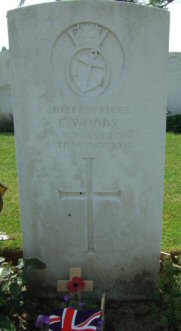 |
Blauwepoort Farm Cemetery is in an isolated spot off the road back to Ypres, and there is a large amount of unused space left where French graves were sited until later removed. Buried there is Private Arthur Hayes of 4th Bn. Middlesex Regiment was a labourer who enlisted aged 18 in 1906 for an original nine years with three in reserve, but was actually moved to reserve in 1911. On 9 May 1915 he was wounded in the trenches north-west of Verbrandenmolen and died the following day aged 28.
Just to the south of Zillebeke Lake is Railway Dugouts Burial Ground, also known as Transport Farm, which is a large, very well laid out cemetery, with plenty of special memorials. The visitors' book is full and close to disintegration. We were visiting: -
Corporal Charles Reeder MM of 'C' Battery, 64th Brigade, Royal Field Artillery, who is commemorated on a special memorial as known to be buried in this cemetery. He was gazetted for the Military Medal in November 1916, possibly for actions during the Battle of the Somme. On 18 July 1917 his battery was in action just north of Zillebeke Lake in heavy rain and under hostile artillery shelling when he was killed or died of his wounds. He is also commemorated on the Accrington war memorial.
Corporal Arthur Qua of 1st Field Coy. Canadian Engineers from Paris, Ontario, a mechanical engineer who had enlisted in October 1914 having previously three years with the 2nd Field Coy. His company were based at Dickebusch and on 4 June 1916, a fine Sunday, he was part of a special party of 50 sappers that reported at Transport Farm to work on excavating a support line to the front line trenches near Valley Cottage. During this Corporal Qua and Sapper / Lance Corporal J Philip were killed; Philip is buried nearby.
In 8½ hours we had only covered 20½ miles but an awful lot of history.
I suspect that that night, after a beer with Alain, we retired to a small pub behind the cathedral for a light supper.
| Continue reading the Salient Tour Account - DAY 7 |
![]()
 Copyright © Mark Gardiner,
March, 2008
Copyright © Mark Gardiner,
March, 2008
Return to the Contents Section